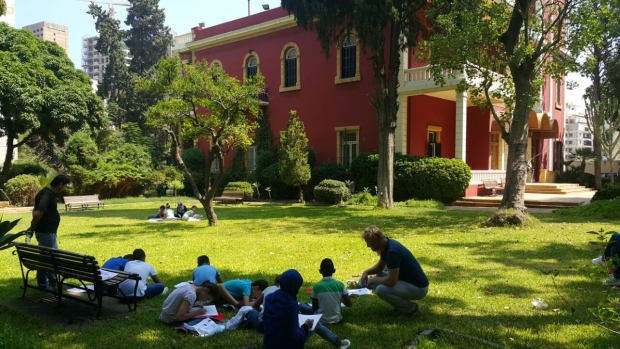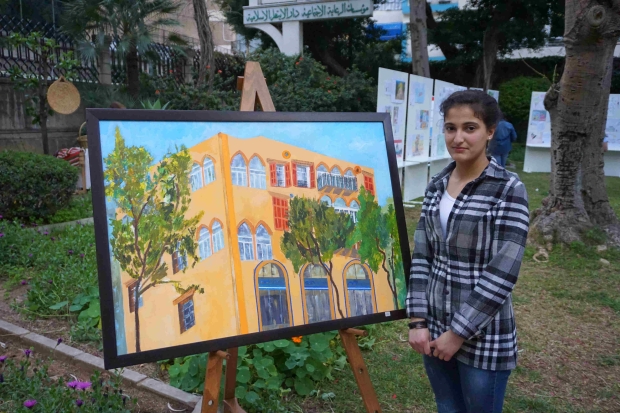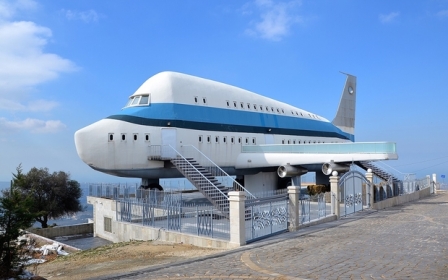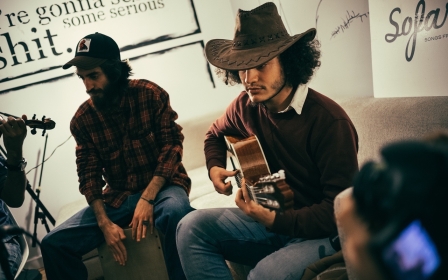Brushstrokes that blur borders: The British artist nurturing dreams in Beirut

BEIRUT - On a recent afternoon, the chatter of children filled the garden of one of Beirut’s few remaining colonial-era homes. Some of them performed songs and danced, while guests browsed the artwork lining the gardens and halls of the home.
Once again, British artist Tom Young had succeeded in connecting the community with art, and in building bridges between the past and the present.
Young first came to Beirut in 2006, when his Lebanese car mechanic in London commissioned a landscape of his beloved homeland. Arriving shortly before the Israeli war against Lebanon, Young was forced to head back to the UK.
“I felt like I had unfinished business in Lebanon.” He returned not only to finish his landscape, but to conduct art workshops with children in some of the areas affected by the war.
For a few years, Young was back and forth between Beirut and London. After falling in love and eventually marrying a Lebanese designer, Noor Haydar, who had come to his Chelsea gallery “to meet this Brit who was painting Lebanon,” Young has now made Beirut his home.
An artist's paradise
A study in contrasts, Lebanon can be an artist’s paradise. Roman ruins are encircled by modern edifices. Snow-capped peaks are an hour’s drive from golden beaches. And of course, the capital of this millennia-old country is Beirut, where historical buildings with colonnaded breezeways and high-arched windows are demolished on a regular basis, and sleek skyscrapers erected in their place.
Since his first commission in Lebanon, Young has been capturing memories with his paintbrush and canvas. He has taken up residency in several of Lebanon’s remaining mansions, many of which are crumbling under the weight of neglect.
Young’s work is inspired by the juxtapositions of the city and country, recording moments in time in an ever-changing environment. In some paintings, the mansions stand in stark relief to the grey urban jungle that surrounds them. In others, wildflowers resist urban decay, and blooms defy concrete and destruction.
“It is sad to see these beautiful places destroyed, and I feel driven to try to use my art to do something, to revitalise that heritage,” Young says.
Building bridges
An artist’s life is often solitary, but Young consistently finds ways to use his passion for painting (and drawing and music) to build bridges with the communities in which he works.
In Tyre, a 4,000-year-old city in southern Lebanon, Young was invited to paint a mural to celebrate World Heritage Day. Over six days in 2015, Young worked at an outdoor site near both the city’s ancient hippodrome and the Al Bass refugee camp for Palestinians, and invited passersby to join him in his work. Lebanese, Syrian and Palestinian children joined in, along with mothers, young couples, and even soldiers, he says.
Using quick-drying acrylic paint, Young and his collaborators painted the mural over and over, creating layers of history until they reached modern day.
Young is committed to working with children, he says. In addition to teaching art workshops in some of Beirut’s most marginalised neighbourhoods, in a Palestinian refugee camp and in orphanages, Young also regularly donates a portion of his sales to Lebanese charities that support the country’s most vulnerable children, he tells MEE.
Dream project
For his latest exhibition, “Beirut: Memory and Dream,” Young collaborated with the Lebanese non-profit Dar al-Aytam al-Islamiyah, a 100-year-old organisation that provides myriad social services, including the support of thousands of orphaned, impoverished and special needs children around the country.
The non-profit’s head office is housed in Al Zaher building, one of Beirut’s architectural gems. Built in 1920, the house was the residence of the British ambassador from 1941 to 1982, and was acquired by Dar al-Aytam in 1986.
Unlike the other crumbling mansions that have served as studios for Young’s residencies, this house (and its gardens) are immaculately maintained. Young says: “It’s a great ‘marriage’ of my interest in preservation of heritage and caring for unfortunate children in society, and it also ties in with my being British.”
Young worked with 34 children, ranging in age from eight to mid-teens. “I just felt immediately that the children should have access to the building. It was important to get kids back into that magical fairytale palace, it would be great for their young imaginations. Kids were brought to the house in buses and taught how to draw the building and gardens.
"We used oil pastels on paper,” Young says. “We inspired each other.”
The children went on walks to see other buildings of architectural interest in the neighbourhood, and Young visited the children at their learning centre, to play music and show films, and to discuss how Beirut is changing.
“They were drawing towers and construction cranes as well as old houses,” says Young, who encouraged the students to think about the contrast and the threats to the city’s heritage, and how to express all of that through art.
After working individually, Young and the students collectively created a pair of mural-sized cityscapes. Beirut was notoriously divided down the middle during its 15-year civil war, and one painting represented a view of the city from east to west, the other from west to east.
Echoing the approach Young used in Tyre, the group first imagined the city in Phoenician times, then under the Romans, Crusaders, Ottomans and French, layering the imagery and capturing each era in photographs before painting over it. Young says: “The layering and superimposing is expressive of history and memory, which is so present in Beirut - it’s an appropriate way to paint the city.”
And Dar al-Aytam were as pleased with the project as the children were, staff say. “It taught the children to express themselves through painting,” says Rania Zantout, a representative of Dar al-Aytam.“It has been important for the children because it gives them the chance to see the beauty of their country, and to know about heritage and architecture. They will grow up admiring their environment and can be messengers for the next generation.”
Young is also a trombonist, and music is often an integral part of his exhibitions. The Zaher house “is a natural theatre, a perfect backdrop,” he says, and he pushed for “Beirut: Memory and Dream” to become a multi-disciplinary event.
On two different evenings, a student choir performed songs in Arabic, while other children performed skits and dances. The impact has rippled out beyond the children of Dar al Aytam, he says, with an overwhelming demand by local schools to come and visit.
Canvassing opinion
Although Young is married to a Lebanese woman, acquiring Lebanese citizenship is not a possibility: national laws only allow citizenship to be passed from man to wife, and not the other way around.
‘I think art exists without boundaries’
- Tom Young, artist
For Young, however, “Lebanon is the country where I live, a country I love. I’m married to a Lebanese woman, and if I have children one day they will be half Lebanese. There are a lot of techniques that I use that are influenced by where I come from. But I’m an artist, and I think art exists without boundaries.”
Many of Beirut’s residents still feel invisible boundaries in the city, based on the lines drawn during Lebanon’s Civil War (1975 to 1990). Young commented that he invited guests from the predominantly Christian neighbourhood of Achrafieh to attend the exhibition in the largely Muslim neighbourhood of Zarif, and “they didn’t know where Zarif was. To come to an Islamic institution was a big step for them”.
Based in a city that struggles against such divisions and the destruction of cultural heritage, Young views art as an alternative power that can “create beautiful magical events and give a sense of joy and meaning”.
He adds: “I don’t like the sense of division that is spreading in the world, and I like to find ways to connect and find middle ground, especially in the Middle East, where there is a chasm of misunderstanding. Cultural places in a sectarian society create a space to come together.” His vision is timely.
New MEE newsletter: Jerusalem Dispatch
Sign up to get the latest insights and analysis on Israel-Palestine, alongside Turkey Unpacked and other MEE newsletters
Middle East Eye delivers independent and unrivalled coverage and analysis of the Middle East, North Africa and beyond. To learn more about republishing this content and the associated fees, please fill out this form. More about MEE can be found here.







